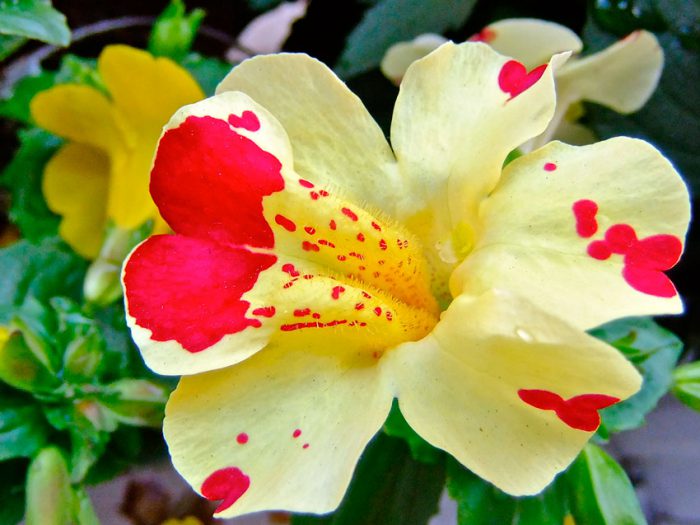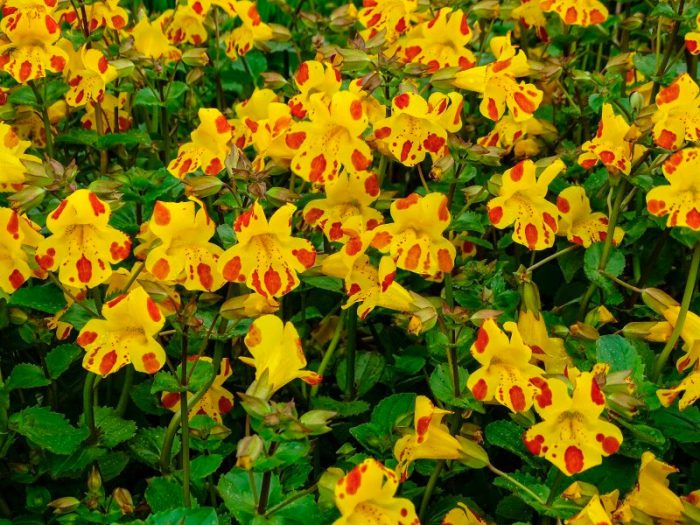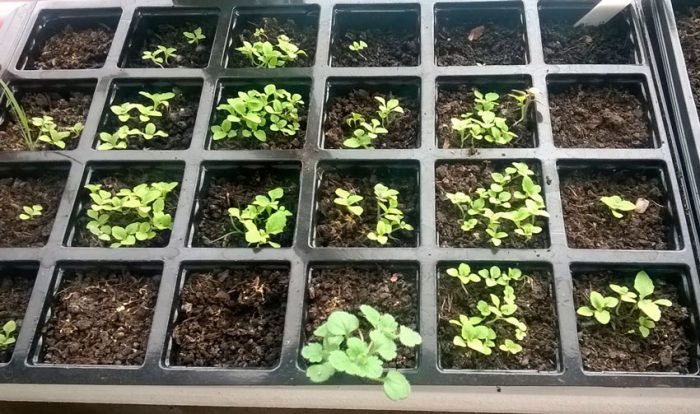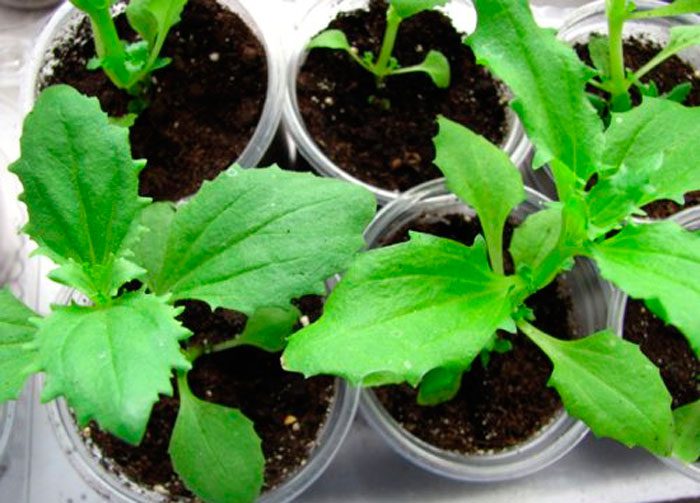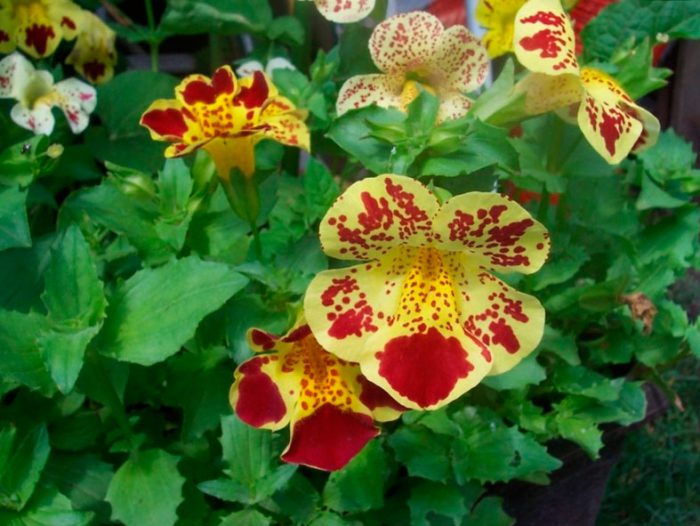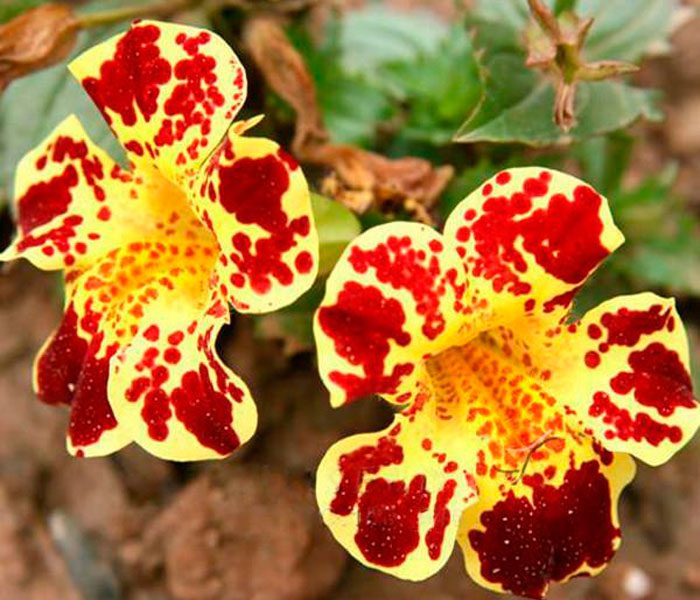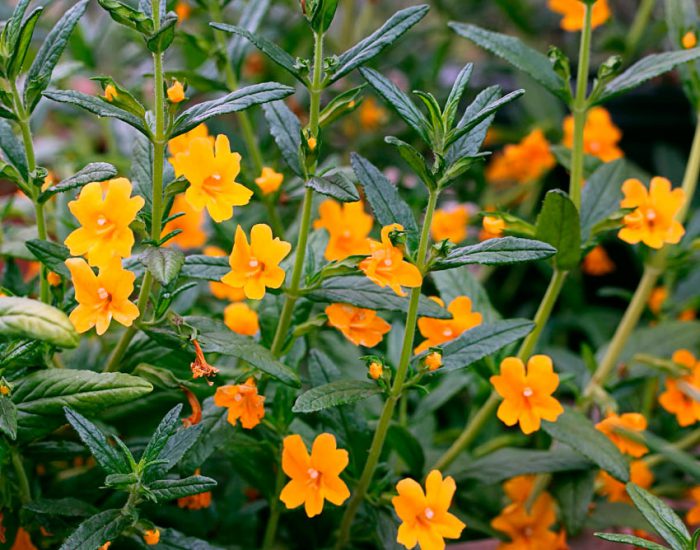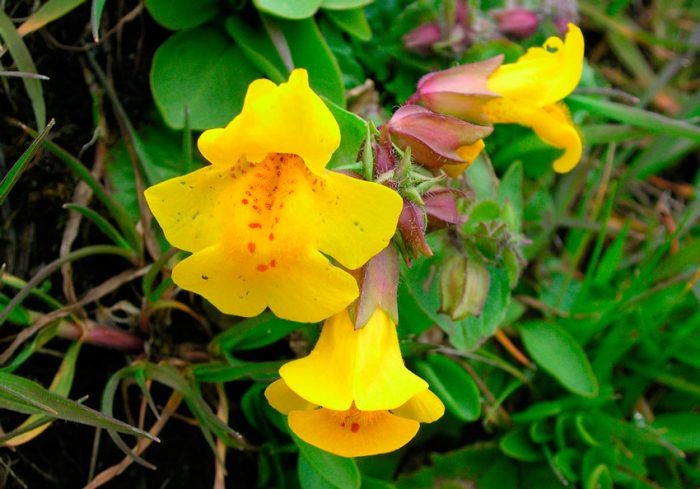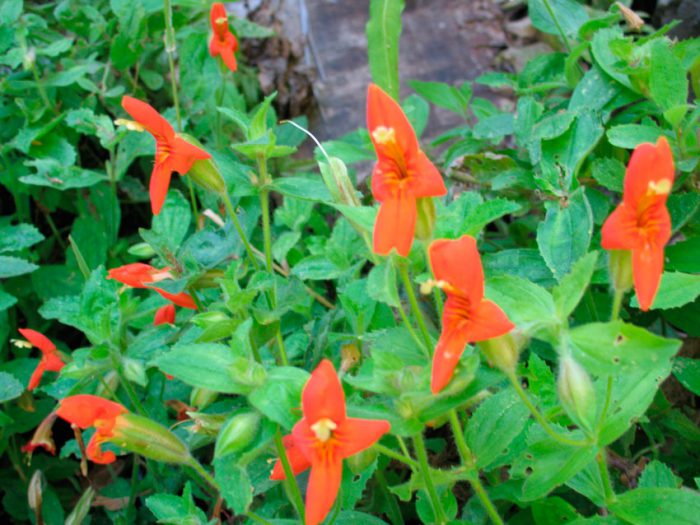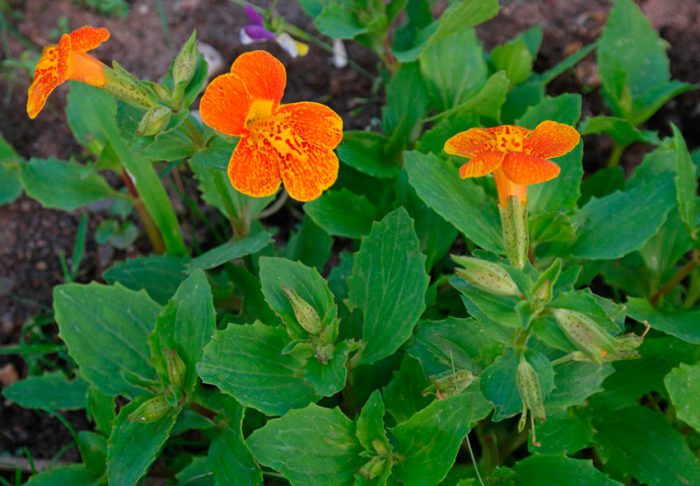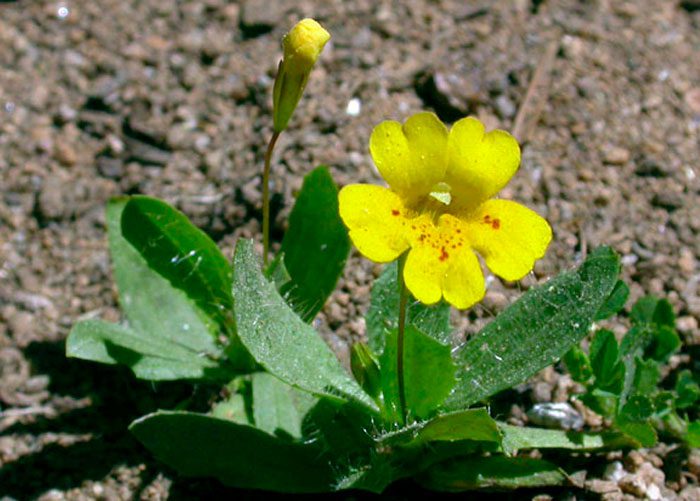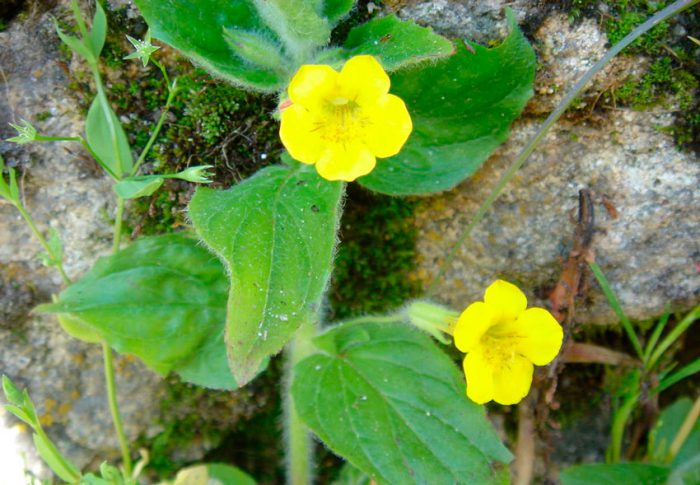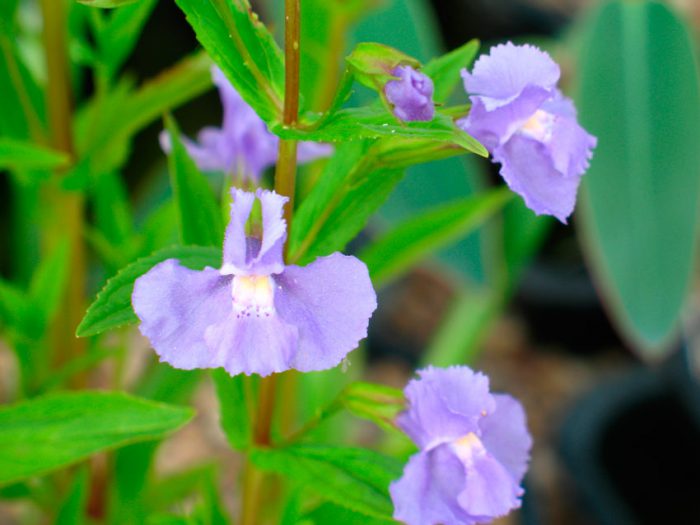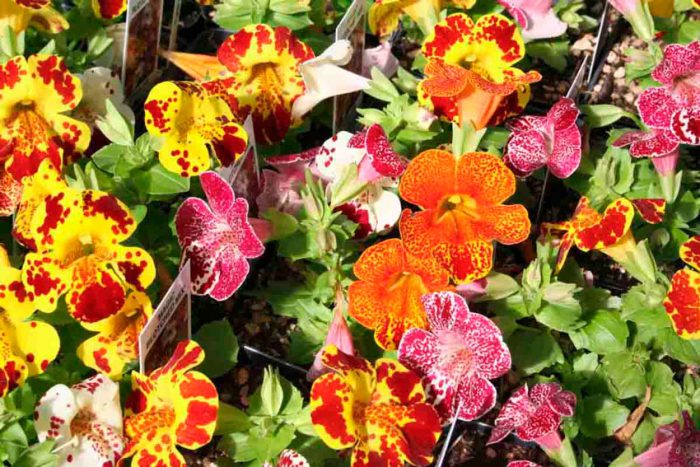Mimulus (Mimulus), also called a lipstick, is a representative of the Frim family. This genus is represented by herbaceous plants and shrubs. Such plants in the wild can be found in all regions with a temperate climate except Europe. Previously, this genus was part of the Norich family. The scientific name of the plant comes from the Latin word "mimus", which translates as "imitator, mime", this is due to the changeable variegated color of the flower, as well as its unusual shape, which is similar to the face of a monkey. This genus unites about 150 species, while most of them in the wild can be found in the western part of North America in damp places, and also in deserts and mountains at an altitude of up to 2.5 thousand meters above sea level. In the middle latitudes, mimulus has not yet gained great popularity among gardeners.
Content
- 1 Features of mimulus
- 2 Growing mimulus from seeds
- 3 Planting mimulus in the garden
- 4 Mimulus care
- 5 Types and varieties of mimulus with photos and names
- 5.1 Mimulus orange (Mimulus aurantiacus)
- 5.2 Pomegranate lip (Mimulus puniceus)
- 5.3 Yellow lipstick (Mimulus luteus)
- 5.4 Mimulus speckled (Mimulus guttatus)
- 5.5 Red lipstick (Mimulus cardinalis), or purple lipstick
- 5.6 Mimulus copper-red (Mimulus cupreus)
- 5.7 Mimulus primuloides
- 5.8 Mimulus musk (Mimulus moschatus)
- 5.9 Mimulus open (Mimulus ringens), or open mimulus
- 5.10 Mimulus tiger (Mimulus x tigrinus), or mimulus tigrinus, or large-flowered mimulus, or leopard mimulus, or hybrid lip (Mimulus x hybridus), or mimulus maximus
Features of mimulus
The flowering plant is perennial, but it is cultivated in the middle latitudes as an annual. But there are quite frost-resistant species that are not afraid of frosts down to minus 20 degrees. The height of semi-shrubs reaches 1.5 meters, while herbaceous plants grow no higher than 0.7 m. Branched creeping or erect shoots can be naked or have pubescence on their surface. Opposite leaf plates are often ovoid. Loose racemose inflorescences consist of spotted or monochromatic flowers that have an irregular shape and reach a diameter of 50 mm. They have a tubular corolla with a bipartite upper lip bent back, while the three-lobed lower lip is pushed forward. The fruit is a box with small brown seeds inside. The ripe box is cracked into 2 parts.
Such a plant is decorated with rock gardens, flower beds, and it is also grown in containers and suspended structures.Mimulus can also be used as a ground cover plant.
Growing mimulus from seeds
Sowing
In room conditions, it is necessary to sow the seeds of the lipstick in the last days of March or the first - in April. Due to the fact that the seeds are very small in size, it is very difficult to evenly distribute them over the surface of the substrate. In this regard, Mimulus seedlings need a mandatory pick. The soil used for sowing should be light and loose, so a universal substrate that includes perlite and coconut fiber is ideal for this purpose, do not forget to add a small amount of clean sand to it. Seeds are simply spread over the surface of the substrate and, without embedding, are watered from a spray bottle. Then the container must be covered with glass or foil and placed in a well-lit, cool enough (from 15 to 18 degrees) place. If everything is done correctly, then you can see the first seedlings after two or three days.
Growing seedlings
After most of the seedlings appear, the plants can begin to stretch. To prevent this, it is necessary to rearrange the container to the most illuminated and cooler (from 10 to 12 degrees) place. It is necessary to water the seedlings daily and do it in the afternoon. It is also recommended to regularly spray the seedlings from a finely dispersed spray bottle. After the fourth true leaf begins to form in the plants, they will need to be dived into individual cups. In this case, 3 or 4 plants should be planted in each cup. When the seedlings take root in a new place, they will need to be fed; for this, potassium fertilizer of low concentration is used. The second time the plants are fed after 1–1.5 weeks.


Watch this video on YouTube
Planting mimulus in the garden
What time to plant
Seedlings should be hardened in the first days of May. As a rule, in half a month of such procedures, the plants have time to fully adapt to outdoor conditions. Planting plants in open soil should be done after warm weather has established, and there is no threat of night frosts, as a rule, this time falls on mid-May. Mimulus can be grown both in partial shade and in well-lit areas. The soil needs humus, loamy, slightly acidic (with the introduction of peat). The site needs to be prepared, for this they dig it, level the surface and water it. Seedlings must also be watered before planting.
Landing features
First you need to prepare the holes. Their size and depth should be such that a lump of earth for the plant along with the root system can freely fit. A distance of 0.2–0.3 m should be kept between the bushes. The seedlings should be carefully transferred into the holes.
In the event that the spring is quite warm in the region where mimulus is grown, then sowing seeds can be done directly in open soil from mid to late April. However, it should be borne in mind that the average daytime air temperature should be kept at around 15-18 degrees. The seeds are simply spread over the surface of the plot and, without embedding in the soil, are covered with a transparent film. The shelter should be removed only after the first seedlings appear. Fortified and grown plants must be thinned out.
Mimulus care
It is quite easy to grow a lipstick, as it is a relatively unpretentious plant. To make the bushes more lush, young plants must be pinched.
This plant is very fond of moisture, in this regard, it must be provided with frequent and systematic watering, especially in summer. It should be noted that the soil near the bushes should always be a little damp. If small holes appear on the surface of the leaf plates, this indicates that watering must be reduced.After each watering, it is recommended to loosen the soil surface near the plants, while pulling out the weeds.
Top dressing is done once every 4 weeks. To do this, use a solution of a mineral complex fertilizer (15 ml per 10 liters of water).
Throughout the growing season, the lipstick blooms 2 times: in spring and autumn. The duration of the first stage of flowering is several weeks. After its completion, it is necessary to trim the bushes as short as possible and feed them. After a short time, they will grow new stems, and the plants will bloom even more luxuriantly than before. In order to preserve the high decorativeness of Mimulus during the flowering period, it is necessary to promptly cut off the flowers and inflorescences that have begun to fade.
Diseases and pests
Grown in the garden, the lipstick is very resistant to diseases and pests. However, the seedlings of such a plant can get sick with powdery mildew or black leg. Infected seedlings must be sprayed with a fungicide solution. In hot weather, there is a high probability of infection of the plant with gray rot. The affected specimens will have to be dug up and burned, because this disease has not yet been effectively treated.
If you water the bushes very abundantly, then gastropods can settle on them. For prevention purposes, the regime and abundance of watering should be reviewed, and the surface of the site should be covered with a layer of mulch (sawdust). Also, these flowers can be chosen by whiteflies and aphids, in this case they will need to be treated with a solution of acaricide, for example, Aktara or Aktellik.
After flowering
Mimulus are perennial plants, but they are thermophilic. If desired, the bushes can be saved if they are cut off in the autumn, carefully removed from the ground and planted in pots that need to be brought into the house. For planting, a not very large container is chosen. These flowers are placed on a windowsill in a fairly cool room. With the onset of spring, the bushes should be planted in open soil.
Types and varieties of mimulus with photos and names
Only a small part of the Mimulus species is cultivated by gardeners. All of them will be described below.
Mimulus orange (Mimulus aurantiacus)
This species is native to the southwestern regions of the United States. The height of such a thermophilic mimulus is about 100 centimeters. The foliage is glossy, dark green. The color of the flowers is salmon pink or orange, the diameter of their corolla is about 40 mm. The stems of such a plant must be tied to a support, because they lean towards the soil surface and begin to creep along it. Such a spectacular flower is often grown in containers and also in hanging baskets. For the winter, it should be moved to a cool room.
Pomegranate lip (Mimulus puniceus)
His homeland is southern California, as well as the border regions of Mexico and the United States. The color of the flowers is iridescent. They can be painted in various shades of dark red. The inside of the corolla is orange in color.
Yellow lipstick (Mimulus luteus)
His homeland is Chile. It was discovered at the beginning of the 18th century by a French priest, Father Feye, who traveled to South America. And in 1763 Karl Linnaeus described such a flower. This perennial plant is cultivated as an annual. The height of branched erect shoots is about 0.6 m. The leaf plates can be bare or have pubescence, and their shape is cordate or ovoid, along the edge there are sharp teeth. Axillary or terminal inflorescences consist of yellow flowers. It has been cultivated since 1812. This species is grown by gardeners relatively rarely.
Mimulus speckled (Mimulus guttatus)
This species was discovered by G.I. Langsdorf in 1808. At the beginning, such plants in nature could only be found in the western regions of North America. After some time, they spread to the east and north of the mainland, and this species also ended up in New Zealand and in Europe (in regions with a temperate climate). This happened due to the fact that this plant is plastic and polymorphic.The height of the bush is about 0.8 m. Shoots are erect and branched. The color of the flowers is yellow, on the surface of the throat of the corolla there is a dark red speck. This species has a variegated form - Richard Bish: the color of the foliage is greenish-gray, there is a white edging on the plates.
Red lipstick (Mimulus cardinalis), or purple lipstick
This species is also native to North America. Such a perennial plant is cultivated as an annual. The pubescent shoot branches from the very base. The height of compact bushes is about 0.4–0.6 m. Opposite ovoid leaf plates have convex veins and a jagged edge. Tubular fragrant flowers have a double-lipped limb, their color is scarlet-red. They are located in the leaf axils on long pedicels. Cultivated since 1853 Popular varieties:
- Auranticus... The color of the flowers is red-orange.
- Cardinal... There is a yellow speck on the surface of scarlet-red flowers.
- Rose Queen... Large pink flowers are covered with dark specks.
- Red Dragon... The color of the flowers is red.
Mimulus copper-red (Mimulus cupreus)
Originally from Chile. The height of such a perennial plant does not exceed 12-15 centimeters. The bare stems rise only slightly from the soil surface. Axillary flowers are located on short peduncles and have an orange-copper or red-copper color, the diameter of the flowers is about 30 mm. Over time, the color of the flowers becomes yellow-golden. Cultivated since 1861. Garden forms:
- Red Imperer... The corolla is colored fiery red.
- Andean Nymph... On the surface of the creamy flowers there is a pale purple speck.
- Rother Kaiser... The color of the flowers is red.
Mimulus primuloides
This perennial plant, unlike other species of mimulus, is cultivated as a perennial. Many thin stems reach a height of 15 centimeters. The rosette consists of oblong or ovoid leaf plates. Long peduncles have yellow flowers.
Mimulus musk (Mimulus moschatus)
This species is a North American endemic. This herbaceous perennial plant has fuzzy shoots and leafy plates that secrete a mucus that smells of musk. In length, the shoots reach about 0.3 m, they can be creeping or erect. The length of opposite leaf plates does not exceed 60 millimeters, they have an oval shape. The diameter of the yellow flowers is about 25 millimeters.
Mimulus open (Mimulus ringens), or open mimulus
This type of lipstick is typical. The height of such a herbaceous perennial can vary from 0.2 to 1 meter. Its shoots are branched. Oval leaf plates are opposite. Small flowers are painted in lavender color.
Mimulus tiger (Mimulus x tigrinus), or mimulus tigrinus, or large-flowered mimulus, or leopard mimulus, or hybrid lip (Mimulus x hybridus), or mimulus maximus
This is the group name for various varieties and forms that were born when crossing yellow mimulus and speckled mimulus. The color of the flowers of these hybrids is distinguished by the fact that it is spotted. As a rule, the height of the bushes does not exceed 0.25 meters. Egg-shaped leaf plates have a serrated edge. The axillary or terminal brushes contain variegated flowers. This type is most popular with gardeners. The most popular varieties:
- Feuerking... The color of the flowers is red, there are brown dots on the surface. The pharynx is yellow.
- Sun in the shade... The height of the bushes is about 0.25 m, the flowers are variegated.
- Viva... The height of the bush is about 0.25 m. On the surface of yellow flowers there are large spots of dark red color.
- Magic Spots... The bush reaches a height of 0.15–0.2 m. There are crimson-red spots on the white-cream flowers.
- Magic Mix... In this variety series, the height of the bushes is about 0.2 m. Pastel-colored flowers are monochromatic and two-colored.
- Twinkle mixed... This series includes plants ranging in height from 0.2 to 0.3 m. The color of the flowers is varied: from deep red to white, from spotted to monochromatic.
- Brass Monkeez... This hybrid ampelous variety has a lush flowering. The flowers are speckled, rich orange.

